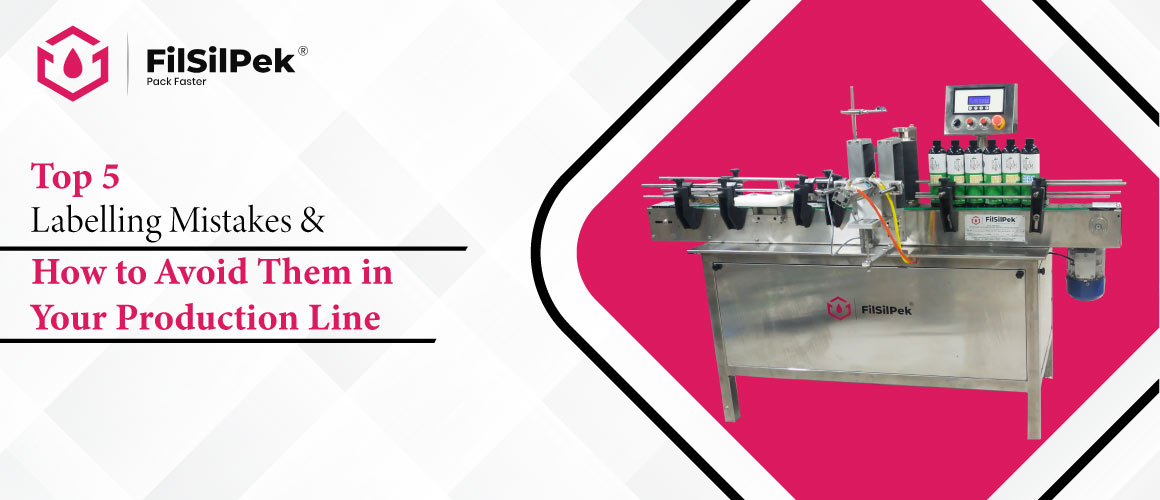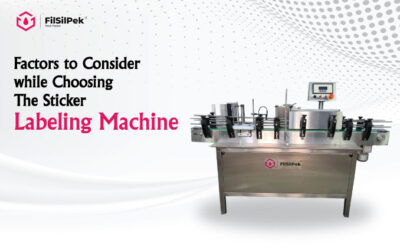Top 5 Labelling Mistakes and How to Avoid Them in Your Production Line
Labelling mistakes are a common yet costly issue in any production line. From misaligned labels to incorrect information, these errors can tarnish your product’s image and lead to significant operational inefficiencies. Not only do they affect the visual appeal and accuracy of your product information, but they can also lead to increased waste, slowed production, and even regulatory fines.
In this blog, we’ll explore the top five labelling mistakes that often plague production lines and provide practical solutions to avoid them. Whether you’re dealing with misalignment, poor adhesion, or inconsistent placement, we’ve got you covered with tips and strategies to ensure your labels are applied correctly every time.
Let’s check out these common pitfalls and learn how to keep your labelling process smooth and efficient.
Common Labelling Challenges and its solutions
Misaligned Labels
Misaligned labels are when labels are placed crookedly or off-centre on a product. This issue can arise from improperly calibrated labelling machines or inconsistent placement of products on the conveyor belt.
Impact in Production Line:
- Products look unprofessional and poorly manufactured.
- Increased waste due to the need for manual correction or replacement.
- Slower production process.
- Higher costs due to rework.
- Damaged brand perception.
How to Solve It:
- Regular Calibration: Ensure that your labelling machines are frequently checked and calibrated. Proper calibration ensures that labels are applied accurately.
- Training Staff: Train employees to place products consistently on the conveyor belt. Consistent placement reduces the chances of misalignment.
- Quality Checks: Implement routine quality checks at various points in the production process. These checks can catch misalignment issues early, allowing for quick corrections.
Incorrect Information
Incorrect information on labels includes errors like typos, wrong ingredient listings, or inaccurate expiration dates. These mistakes often stem from data entry errors or outdated label templates.
Impact in Production Line:
- Regulatory fines and potential legal issues.
- Product recalls.
- Damaged brand reputation.
- Loss of customer trust.
- Decreased sales.
How to Solve It:
- Double-Check Data: Implement a robust data verification process to ensure all label information is correct before printing.
- Update Procedures: Regularly review and update label templates to reflect any changes in product ingredients, instructions, or other critical information.
- Proofreading: Assign a dedicated team or individual to proofread labels meticulously before they are printed. This additional layer of oversight can catch errors that automated systems might miss.
Poor Adhesion
Poor adhesion occurs when labels don’t stick properly to the product or start peeling off. This problem often arises from using the wrong type of adhesive for the product’s material or due to environmental conditions such as moisture and temperature.
Impact in Production Line:
- Difficulty in product identification.
- Delays in inventory management and shipping.
- Unprofessional appearance.
- Increased rework and waste.
- Potential for lost sales.
How to Solve It:
- Choose the Right Adhesive: Select an adhesive that matches your product’s material and the environmental conditions it will face during storage and transport.
- Environmental Control: Maintain a controlled environment for labelling to ensure optimal temperature and humidity levels, which can improve adhesive performance.
- Test Runs: Conduct test runs to evaluate the adhesive’s performance under various conditions. This allows you to make necessary adjustments before full-scale production.
Label Overlap
Label overlap occurs when labels are applied too closely together or bunch up. This issue can result from incorrect label sizing or improper spacing settings on the labelling machine.
Impact in Production Line:
- Barcodes become unreadable.
- Complications in product identification.
- Unprofessional appearance.
- Slowdown in production due to manual fixes.
- Increased labour costs.
How to Solve It:
- Proper Sizing: Ensure labels are the correct size for the product. Oversized or undersized labels can cause overlap and bunching.
- Machine Settings: Adjust the labelling machine settings to ensure adequate spacing between labels. Proper settings help prevent overlap and maintain a neat appearance.
- Routine Maintenance: Regularly maintain your labelling equipment to ensure it operates smoothly. Well-maintained machines are less likely to encounter issues that cause label overlap.
Inconsistent Label Placement
Inconsistent label placement means labels are not uniformly applied across products. This inconsistency can result from manual application errors or malfunctioning automated systems.
Impact in Production Line:
- Disrupted brand consistency.
- Difficulty in scanning barcodes.
- Operational inefficiencies.
- Customer confusion.
- Reduced professional appearance of products.
How to Solve It:
- Automate the Process: Use automated labelling machines to ensure consistent label placement. Automation reduces the risk of human error and increases efficiency.
- Sensors and Cameras: Implement sensors and cameras to monitor label placement in real-time. These devices can instantly adjust the process to correct any misplacement.
- Employee Training: Train staff on the importance of consistent label placement and the best practices to achieve it. Well-trained employees can quickly identify and rectify issues, ensuring uniformity.
How Automatic Labelling Machines Can Be the Best Solution?
Automatic labelling machines are like having an extra pair of expert hands on your production line. They place labels with precision, ensuring each one is spot-on every time. This accuracy is hard to match with manual labelling, and it makes your products look consistently professional.
Speed is another huge perk. These machines can label hundreds, even thousands, of products in the time it takes a person to label a few dozen. This boost in efficiency means your production can ramp up without needing extra manpower. Plus, it frees up your team to focus on other important tasks.
While it might seem like a big investment at first, an automatic labelling machine pays off in the long run. You’ll save on labour costs and reduce waste from mislabeling. These machines are also versatile, easily handling different product sizes and shapes, which means they can grow with your business.
Integrating an automatic labelling machine into your production line is a breeze. They work seamlessly with your existing setup, making real-time adjustments to keep everything running smoothly. It’s a smart move that can enhance your overall productivity and product quality.
Wrapping it up
At Filsilpek, we understand the critical role that precise and efficient labelling plays in your production line. Our advanced automatic labelling machines are designed to tackle common labelling challenges, ensuring your products always look their best and meet all regulatory standards. Whether you’re facing issues with misalignment, incorrect information, or inconsistent placement, our innovative solutions are built to keep your operations running smoothly and efficiently.
We take pride in offering reliable, high-quality labelling machines that enhance productivity and reduce errors. Our commitment to excellence means you can trust us to deliver the best labelling solutions tailored to your specific needs.
If you’re ready to upscale your labelling process, reach out to us at [email protected] or call us now.
The Important Role of Sticker Labeling for Building Brand Trust in Pharmaceutical Industry
In the pharmaceutical industry, trust is everything. Patients rely on pharmaceutical companies to provide safe and effective products that…
Frequently Asked Questions about Automatic Sticker Labeling Machine
In modern manufacturing, the role of automatic sticker labeling machines stands out as a cornerstone in optimizing efficiency and ensuring precision. These sophisticated…
Factors to Consider while Choosing The Sticker Labeling Machine
Have you ever given a thought, how businesses manage to quickly and accurately label thousands of bottles? The groundbreaking development of…



